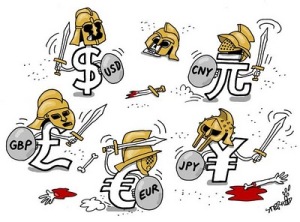For those of you that didn’t know, I spent the last three days in London taking my only class of the semester (and my final class of my undergraduate career). FNCE396: Finance in Europe was a 3-day seminar in London where we heard from three professors and a number of industry professionals (hedge fund managers, bankers, private equity associates, investors, and even Margaret Thatcher’s former economic advisor). The class was a great way to close out my time at Penn. Being able to spend it in Europe, where my passion for studying political economies and global macro began, truly made it a memorable experience. Here are my 5 key takeaways from the seminar:
1. The European Union is more about politics than economics

This was by far the most important takeaway from the seminar. In order to understand the European Union, you need to understand European history. You need to understand that it has been the bloodiest continent for the last century. It has been torn apart by two world wars and was the epicenter of one of the most calculated genocides in human history. The European Union started as the European Coal and Steel Commission (ECSC) primarily between France and Germany as a means of preventing another world war. The previous prevention strategy, completely suffocating and humiliating the loser, had miserably failed. Over the last 50 years, the EU has evolved to be an economic common market where free trade agreements and the promotion of labor mobility has helped to bolster the European economy. However, this process was accomplished not primarily for economic reasons, but rather for political ones. The last 50 years has been process of European harmonization: an attempt to bring Europe together, to understand one another, and to prevent another world war.
The Euro has been the messiest policy implementation thus far. To further economic development (and thus political harmonization), the Euro was introduced as a common currency in 2002. While some may not have truly understood the ramifications of creating a monetary union in the absence of a fiscal union, economists certainly did. In the end however, the politicians had the final say.
Germany, with its competitive export industry artificially held down by a weaker currency boomed throughout the 2000s. They reorganized many of the outdated continental labor systems and have, by and large, been the center of Europe (something that they failed to achieve just half-a-century earlier). The problems started to arise when the South (Italy, Greece, Portugal), who had historically weak currencies (high inflation, high interest rates) started to have the stability of a Germany currency (low inflation, low interest rates). What did they do? They borrowed, borrowed, and borrowed some more. They ran up their debt levels.
Then in 2008, the US credit market blew up. Sending shockwaves throughout the world, the global economy stagnated, and suddenly debt-to-GDP levels started skyrocketing. These problems were very noticeable in Greece, Portugal, and Italy.
Spain, believe it or not, had some of the most manageable debt levels in Europe, at 40% of GDP. But because of their rigid labor markets, the crisis not only decimated government tax revenue, but expenditures skyrocketed as a result of unemployment compensation. 25% unemployment today is a result of both economic stagnation and an incentive structure that prevents labor force participation. Spain pays its people to stay unemployed. Why work when you can get money from the government every week?
And here we are today with Germany attempting to reform the EU. Normally, poor countries would devalue their currency. On the Euro, they can’t. The two possibilities are both problematic economically, but even more so politically. Natural devaluation involves wage cuts. Economically, this can suffocate consumer demand. Politically, it leads to social unrest and rioting. The other mechanism is inflation. Economically, it destroys the currency’s stability. Politically, it transfers money from Germany to Greece and Italy. At an even deeper political level, German hyperinflation throughout the 1920s led to a political vacuum giving rise to Hitler’s Nazi party. Here again, we see economic history influencing today’s politics.
So now we have an awkward case of Southern countries unwilling to reform, an unwillingness of Northern countries to help, and a troubled currency and economic union. Many economists and many on Wall Street thought the Euro was doomed and it was only a matter of time before certain countries would splinter off and the EU project would fall apart. But these economists (trained in a one-dimensional discipline) have ignored the political nature of the EU. The EU is meant to bring all of these countries to the table to discuss their issues and work through them. Clearly this current crisis is a bump in the road, but might it lead to more political communication, an enhanced international understanding, and eventual political harmonization throughout continental Europe. Only time will tell.
2. The EU will never be the US; there are too many cultural barriers
Once the Americans had defeated the British in the American Revolution, it became time to decide on the union. One of the most influential American revolutionaries was not a President, but a Treasury Secretary. An avid Federalist, Alexander Hamilton, saw America in a far more prophetic way than some of the more famous Americans (e.g. Thomas Jefferson). Where Jefferson believed in an agrarian lifestyle centered around state-held power, Hamilton understood that a strong political union would lead to better coordination and, in time, generate economic prosperity. Had Jefferson gotten his way, the US might look like the EU.
The political institutions for economic harmonization (a common currency, a federal system of transfer payments, a common language, and flexible labor mobility) have been in place since 1789. Europe achieved the first in 2002 and still doesn’t have the following two. While labor mobility was supposed to be in place years ago through the European common market, it has failed. Why? Without a common language, it is nearly impossible for a Spaniard to work in Germany. Cultural differences have also created racial tensions that persist to this day. Moreover, social welfare states make countries less likely to accept foreigners (there is no better example of this than in Denmark).
Does this mean that Europe is necessarily worse than the States? Yes and no. Economically, it is less flexible, less suited to compete in a global economy. Politically, it is much more fragmented. But these differences also have their hidden strengths. The European Union will continue to develop and because of its unique history, it will develop in a slightly different manner than the US. European culture is nothing like American culture, and in my opinion, these cultural differences make Europe a unique place unlike any other. If Europe can leverage its differences and synergize them creatively, it will surely rebound in a robust way.
3. The UK will probably leave
This may be a more politically-charged observation but definitely one with some merit. The UK has always had reservations about joining the EU. It was a reluctant member from the very beginning. When the Euro was proposed, the UK said “No, thanks. We’re good.”
The UK, while obviously European, has never thought of itself as distinctly European, at least not in the continental sense. We all remember the US’s hesitancy in its WWII engagement, but England’s aversion was even worse. Chamberlain appeased Hitler, allowed him to take much of central Europe, and never really intended to back up France until its own island was subjected to Germany’s blitzkrieg attacks. While economically weakened from unproductive colonies and WWI, its reluctance to fight the Nazis speaks volumes about its political position within Europe.
Sir Norman Blackwell, chief economic advisor to Margaret Thatcher, spoke to our class on Monday. Politically charged, he stood to the far right of the stage. But more importantly, he stood firm and answered all of our questions in stride. He believed the Euro project to be a mess and was very clear that the UK should have no further role in its development. And truthfully, he had some very fair points.
The Euro crisis is far from over. Since Greece started asking for bailout money nearly 5 years ago, the fundamental problem has been unresolved. It will be years before countries agree on fiscal unity. It will be years before labor markets are reformed. The South needs to adapt to global economic conditions. France needs to as well. And something that could only be written in a Hollywood movie script, Germany, after failing to conquer Europe in two major wars, will reluctantly lead the continent in its quest for political unity. The question for the UK is: Can they wait?
While not tethered to the Euro, England is still subject to many of the leftist policies pushed through Brussels. Recent banker compensation caps are just an example, but trading restrictions and other financial disincentives truly hurt the UK. London is Europe’s center of finance. A friend asked me why. I didn’t know off the top of my head, but it took me all of 10 seconds to figure it out. It is the only European country to speak English as its first language. Tokyo, Singapore, and New York all do business in English, not German, not French, not Swiss, and certainly not Italian. How could Europe’s financial capital be anywhere else? And if Brussels wants to experiment with market distorting policies like they are currently doing, it is best for England to go in a different direction.
Blackwell also made the point of focusing on a global economy. He expressly mentioned England’s important relationships with other capitalist democracies, namely the United States and India. England is distant from Europe because for centuries before WWII, the sun never set on its global empire. From India to South Africa to Canada, its island has been a global force, not a continental one. In visiting London, you don’t get the sense of being in Europe; it’s quite different. It’s not necessarily the language, but its also the melting pot of cultures, the variety of languages, and eclectic collection of its people. London is an international epicenter, a pioneer in free trade, and a stalwart in liberalized markets. The UK needs to continue in that direction. Instead of cleaning up continental Europe, maybe it is in the UK’s best interest to part ways and focus its political economy on the rest of the world.
4. Demographic changes will be increasingly important
Much of the developed world will suffer from stagnating populations. In short, a woman needs to give birth to 2.1 children in order to keep populations at a constant level. Anything below will create population decline. For the last 30 years, birthrates across many developed countries have fallen and are continuing on a disturbingly linear trend line.This phenomenon is a problem in many developed countries for a number of different reasons.
The US is in a precarious situation. Japan is too. Europe, especially continental Europe, is in dangerous territory. Germany and Austria have reproduction rates between 1.1-1.4, well below the 2.1 rate of population sustainability. Why is this a problem? Social welfare systems, for one, will demand higher payments from a contracting tax base. The US has a problem with entitlement spending but it palls in comparison to Europe’s social programs.
Even if you eliminate these programs entirely, population decline continues to pose problems. A contracting labor force might appear to demand less jobs which could solve the unemployement problem, right? Wrong. Less jobs means less income which means less consumer demand. The economy shrinks. The whole idea of the European common market was to expand Europe’s economy, to foster a greater and less inhibited exchange of goods, services, and ideas. Even if the Euro succeeds, population declines will reverse many of these developments. Less labor means fewer innovators and fewer entrepreneurs. What is most tragic is that this problem is seemingly solution-less. How do you convince an entire population to have more kids? Deciding to have children is such a uniquely personal decision, and one that does not respond to any form of external incentives. Maybe, trends will change. Maybe this is just a cycle…
5. Don’t confuse cyclicality with trends
Not uniquely European in nature, but an important point nonetheless. Europe is struggling and it looks problematic. But once you take a step back and realize that Europe has been in a process of integration for 50 years, this current debt-to-GDP debate doesn’t look so bad. Take a further step back and compare this crisis to WWII, WWI, the Black Plague, or the collapse of the Roman Empire. This is not even a comparative blip on Europe’s radar.
China was a world superpower in the years before the Mongolian invasion. All sorts of inventions from gunpowder to clocks to paper to money came from the Orient. And then for nearly a millennium, China shut down. I’m not a Chinese historian, but it is worth noting that one of the most influential regions of the world stagnated for a very long time. Napoleon once said, “Let China sleep, for when she awakes, the world will tremble.” China, today, is growing at a clip nearly 5x faster than any developed economy. It is doing so in a uniquely Chinese way and is reversing its fortunes after years of stagnation.
The point is simple. The world isn’t fixed. Cyclicality is a natural part of life. Things go up, then they come down, then they go back up. Europe may look lost today, and maybe they are. But Europe’s history and unique culture makes it unique. Its roots are spread deeply throughout the entire world.
Remember, Greece and Rome dominated for nearly a millennium. When Rome finally collapsed in the 600s, Europe declined. It took one of the world’s worst disasters, the black plague, to ignite the Renaissance which sparked the Industrial Revolution. For 500 years, Europe was the center of the world. Today, it is clearly in remission. But history tends to repeat itself, and it is inevitable that Europe, with its global reach, its historical roots, and its geographic centrality, will make it an important place to do business for many years to come.








